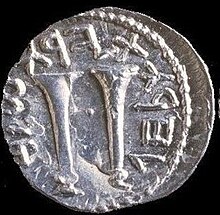Chazozra
Chazozra , also hazozra, hasosrah, hasoserah, plural chazozrot , hasoserot , was a natural trumpet of the Israelites used in religious rituals , which was made of bronze or silver or silver alloys. The chazozra is in the Old Testament mentioned 31 times and is in the Vulgate with tuba translated. The first written description of the chazozra is probably recorded in the 4th book of Moses . The prophet Moses is asked by Elohim : "And the LORD spoke to Moses, saying: Make you two trumpets of beaten silver ..." ( 4 Mos 10 NIV )
The design of the straight metal trumpet chazozra can be distinguished from the curved natural horn shofar . While the word shofar goes back to Akkadian , chazozra is based on the Hebrew consonant root ḤṢR ("housing", "fence", derived from "tube"). The shape, but not the name, seems to have been imported from Egypt and to go back to the simpler Egyptian military trumpet scheeb , which produced only two tones. The chazozra was usually played in pairs. While the chazozra is part of the institutionalized sacred area and the circle of power of the Second Temple , the shofar belonged to the magical-mystical worship of God.

According to the Bible, “... 120 priests who blew with trumpets participated in the dedication of the Temple of Solomon . And it was as if it was a man who trumpeted (...) like listening to praise one vote and thank the Lord. "( 2 Chr 5.12 to 13 LUT )
When the Second Temple was destroyed in 70 at the end of the Jewish War , the stolen temple equipment was brought to Rome . An illustration of this can be found in the form of two reliefs on the Arch of Titus in Rome (c. 70), which were only added around 190. Flavius Josephus specifies the length of a chazozra in his writing Jüdische Antiquities with a "short cubit" (approx. 46 cm).
See also
literature
- Edward H. Tarr: The Trumpet . Schott, Mainz 1984. ISBN 3-7957-2357-4
Web links
- Flavius Josephus: Antiquities of the Jews III, 12.6. Christian Classics Ethereal Library at Calvin College, August 22, 2006, accessed December 10, 2012 .
Individual evidence
- ^ Abraham Zevi Idelsohn: Jewish Music - Its Historical Development . Henry Holt & Company, New York, 1929, pp. 10f
- ^ David Wulstan: The Sounding of the Shofar. In: The Galpin Society Journal, Vol. 26, May 1973, pp. 29-46, here pp. 30,41
- ↑ Joachim Braun: Biblical musical instruments. IV instruments. 4. ḥǎṣôṣrā. In: MGG Online, November 2016
